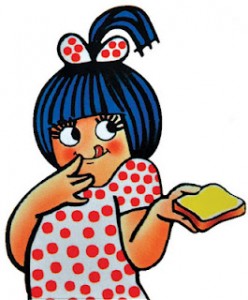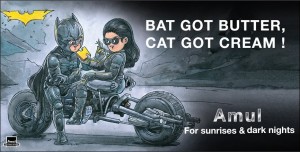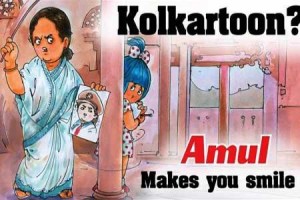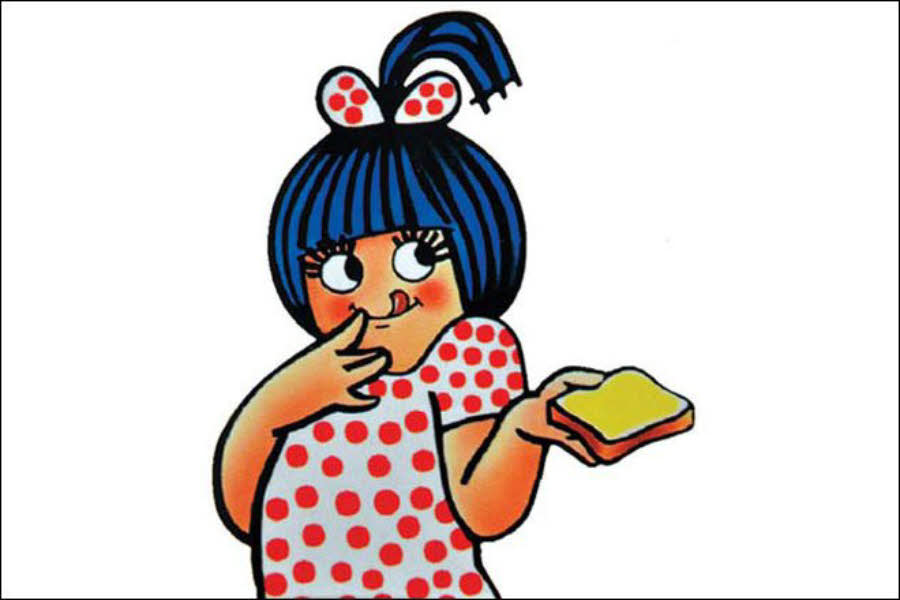I have always liked that girl with the blue hair – yes, the one who wears a red polka dress. And what I have liked most about her are those big eyes that brim with childish innocence.
There’s something utterly cute about her and the way she stands up and speaks her mind out from billboards on busy roads. Yes, something utterly, butterly delicious!
Welcome to the smashingly creative universe of the Amul girl and Amul ads – an ad campaign that has been running for close to 50 years now and is undoubtedly one of the most successful in the world.
The Amul Girl
 If a carefree kiddo announces her opinion on all things interesting happening in the country, the condescending adult in us may question “what does she know?” But this is the Amul girl –so nobody really asks because she has waved her magical wand and charmed one and all over the years, conquering fans across all age groups. She has proved, time and again, that innocent though she may be, she is witty, intelligent and extremely adorable. And more importantly, even though she is witty and intelligent, she has lived up to the fact that she can never be cunning. And that’s why her followers love her and adore her, so much so that her creators, daCunha Communications, have refrained from giving her any image makeover in all these years.
If a carefree kiddo announces her opinion on all things interesting happening in the country, the condescending adult in us may question “what does she know?” But this is the Amul girl –so nobody really asks because she has waved her magical wand and charmed one and all over the years, conquering fans across all age groups. She has proved, time and again, that innocent though she may be, she is witty, intelligent and extremely adorable. And more importantly, even though she is witty and intelligent, she has lived up to the fact that she can never be cunning. And that’s why her followers love her and adore her, so much so that her creators, daCunha Communications, have refrained from giving her any image makeover in all these years.
Just like how the little girl has been a favourite, the ads she has been part of too have had a solid following, clean reputation and undying charm, reflecting, like a blemish-free mirror, all the evolutionary changes that this country has seen, in the process, serving to boost the brand image of Amul.
Bringing that Smile On
I don’t remember when exactly I started following the Amul billboards. But what I do remember is that these ads have made me smile whenever I have run into one on the road. It’s the sort of smile that spreads across your face as a result of two things – one, a realisation of how true what you are seeing is, and two, an admiration of the creativity that made this realisation possible.
I have always been impressed with the brilliant word play at work in these ads, the versatility in the implementing style, the cartoons in particular, and the thought-provoking take they present on very relevant current affairs. And of course, I have been in awe of how, in recent years, the team has quickly lapped up issues that have caught public attention and won their awe, and in some cases, provoked their ire too, and given it the perfect Amul treatment. From one ad that used to come out every week, the frequency of Amul ads per week has now started going up.
Take, for instance, the incredible speed with which they came up with ads for Gagan Narang’s bronze medal win at the London Olympics (“Door Gagan Ke Wow Mein”) and the phenomenal expectations amid which Christopher Nolan’s concluding film of the Batman trilogy, ”The Dark Knight Rises”, released (“Bat Got Butter, Cat Got Cream”) . I especially liked the one they came up with following Time Magazine’s cover showing a photograph of Manmohan Singh and calling him “The Underachiever”. The Amul ad, taking from this, showed a bespectacled Amul girl, posing just like Dr.Singh, with the words, “The Wonderachiever”, written over her image.
Wow Mein”) and the phenomenal expectations amid which Christopher Nolan’s concluding film of the Batman trilogy, ”The Dark Knight Rises”, released (“Bat Got Butter, Cat Got Cream”) . I especially liked the one they came up with following Time Magazine’s cover showing a photograph of Manmohan Singh and calling him “The Underachiever”. The Amul ad, taking from this, showed a bespectacled Amul girl, posing just like Dr.Singh, with the words, “The Wonderachiever”, written over her image.
The Two Line Saga
Rahul da Cunha, Creative Director, daCunha Communications, Manish Jhaveri, popular copywriter, and Jayant Rane, artist, form the creative force behind the Amul ads. Those who have followed the hoardings closely will realise that there are two parts to the wordings in an Amul ad – one, a one-liner (in most cases) that stamps the issue out and two, Amul’s connection to the episode. These are perhaps why, as a writer, I love Amul ads so much – it really isn’t easy to compress and present the magnitude of an issue in three to five words, particularly when it is something that concerns a nation of one billion people! The concepts in the ads thrive on amazing puns and Hinglish and spell magic at the slightest tweak of a word.
“Kha – na Hazare” with the Amul tagline “Lok Priya Makhan” worked intelligently on Anna Hazare’s name, while trying to urge Hazare to end his fast. It’s also interesting to see how the ad pitches on the word “Lok” (keeping in mind, Lokpal) to declare that Amul butter is people’s favourite. Take a look at this ad “Nonsensex” that cleverly nailed the miserable performance of the stock markets by merging two words “Nonsense” and “Sensex.” And the puzzled moppet with “I have no clue what’s happening” expression on her face is just what the ad needed. Of course, the ad went on to claim that Amul was indeed “safe investment.” Another one of my personal favourites is “Swad Dish” that was a very interesting pun on Sharukh Khan’s “Swades” with the Amul tagline reading “Eaten by we the people”.
Telling the Indian Story
An interesting truth that emerges from observing Amul ads ever since it first came out in 1966 is the way it has mirrored the workings of a diverse and happening country like India, spanning a wide range of topics from politics to issues of social relevance to sports to Bollywood. Amul billboards have also focused on important international events but a significant share of its attention has been given to the affairs in this multifaceted subcontinent.
 Politics, no doubt, has remained an interesting space to explore and perhaps, is one domain that has opened doors to controversies. One of the campaigns that stands out was an ad that came in the 1970s – during Indira Gandhi’s Emergency period. “We’ve always practised compulsory sterilisation” was a smart take on the mass sterilisation program that was on during those years. More recently, another very interesting billboard spoke of “Radia-active disclosures!” in the wake of the 2G scam, with the Amul tagline saying “in leak proof packs.” In yet another instance, after Mamata Banerjee’s sharp reaction to cartoons, the Amul ad aptly said “Kolkartoon.” And those are just few examples!
Politics, no doubt, has remained an interesting space to explore and perhaps, is one domain that has opened doors to controversies. One of the campaigns that stands out was an ad that came in the 1970s – during Indira Gandhi’s Emergency period. “We’ve always practised compulsory sterilisation” was a smart take on the mass sterilisation program that was on during those years. More recently, another very interesting billboard spoke of “Radia-active disclosures!” in the wake of the 2G scam, with the Amul tagline saying “in leak proof packs.” In yet another instance, after Mamata Banerjee’s sharp reaction to cartoons, the Amul ad aptly said “Kolkartoon.” And those are just few examples!
What’s also noteworthy is that many of the hoardings are region-specific too. In an article that appeared in Mid-day, Rahul daCunha reveals that there are four Indias as far as their target audiences for Amul ads are concerned. These are Mumbai, East India, South India and the Hindi belt, which includes the predominantly Hindi speaking states. Down south, Jayalalitha, Karunanidhi and Rajinikanth are the show stealers while the Hindi belt is attracted more towards political views. The Mumbaikars, understandably, love Bollywood!
As we discuss the journey of Amul ads, tracking India as it moved on, it has to be pointed out that young, urban India’s growing affection for social networking and technology also hasn’t missed the Amul girl’s scrutinising eyes. And so came in a series of ads that reflected this trend. “i-Fun, “Face bhook” and “eeek-mail” (based on the virus) were promptly up for Indians to see and smile.
For an Amul ad fan, no space is quite enough to discuss the sparkling creativity in those billboards. And that is because creativity in this case has assumed an unbelievable number of dimensions and well, it doesn’t stop with that. Each of these dimensions is unique and renders itself beautifully to the chosen concept. The nuances in almost all of the ads need to be picked and rejoiced slowly and carefully. For a mind thirsty for creativity, Amul ads are a sure refuge.
But beyond all this, what truly stands out is the very reason why the journey has come this far – what has sustained this campaign? The answer is not very tough to arrive at. There is this something – honesty, steadfastness or a certain forthrightness – call it whatever you want, that people acknowledge knowingly or unknowingly about the Amul ad campaign, so much so that these ads are taken for granted – as a part of the everyday life of an urban Indian. And for all the joy and food for thought that these ads and the dear moppet have given Indians over the years, let’s just hope that this saga continues for many years to come. In fact, as a mother, I look forward to the day when my son and I catch each other smiling and exchange a twinkle in our eyes in mutual agreement, seeing another timely Amul billboard on yet another ordinary Indian road. That, I really think, should be fun. Real fun.
